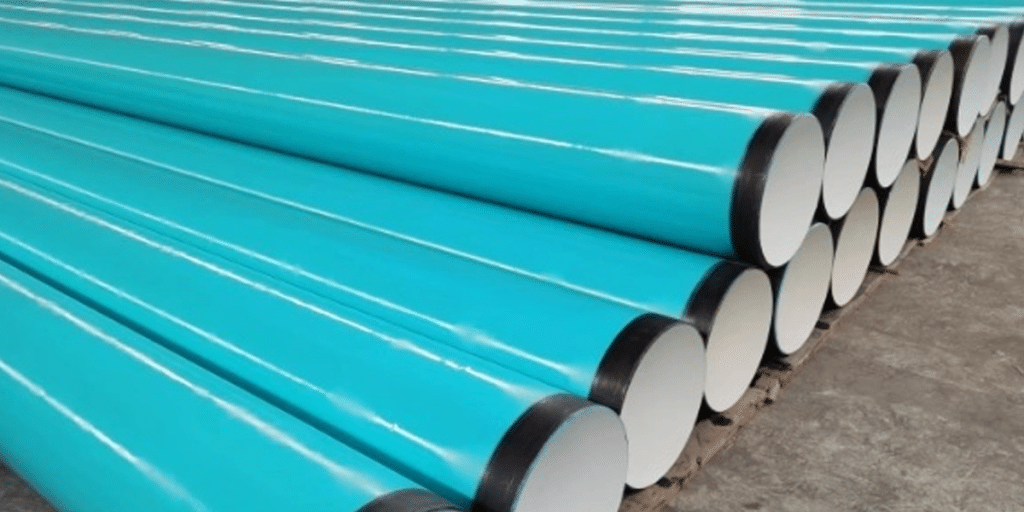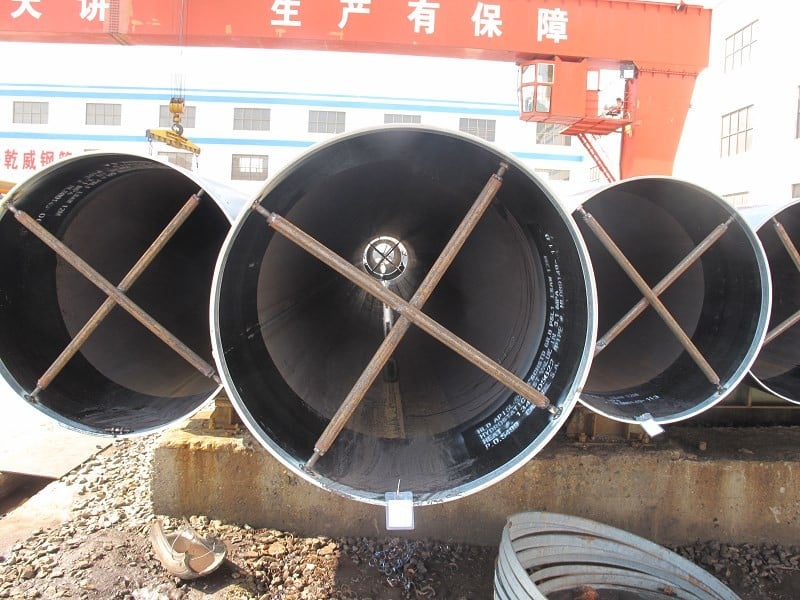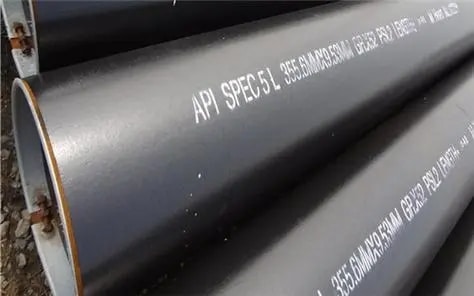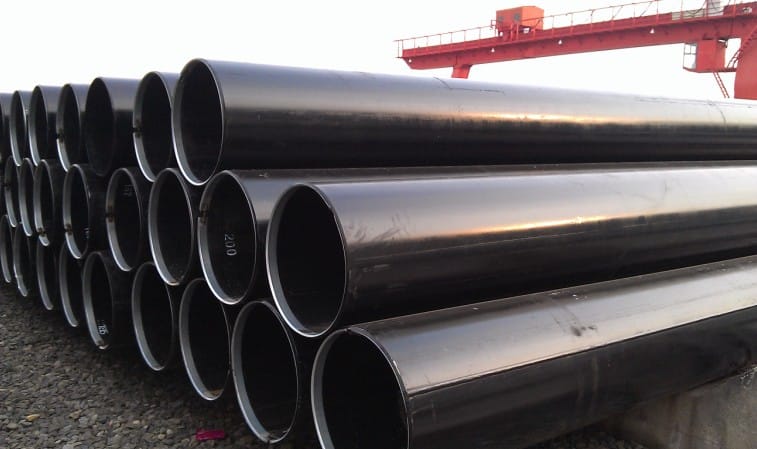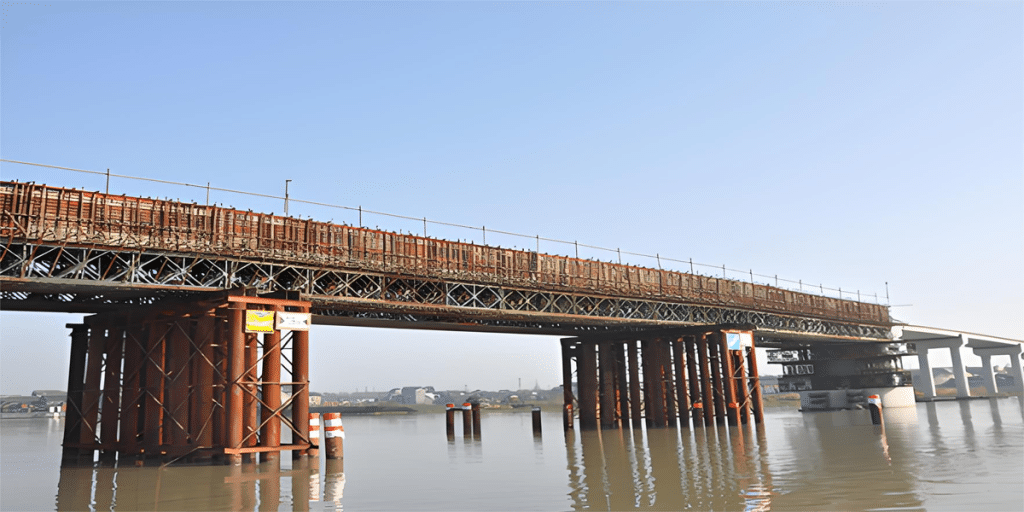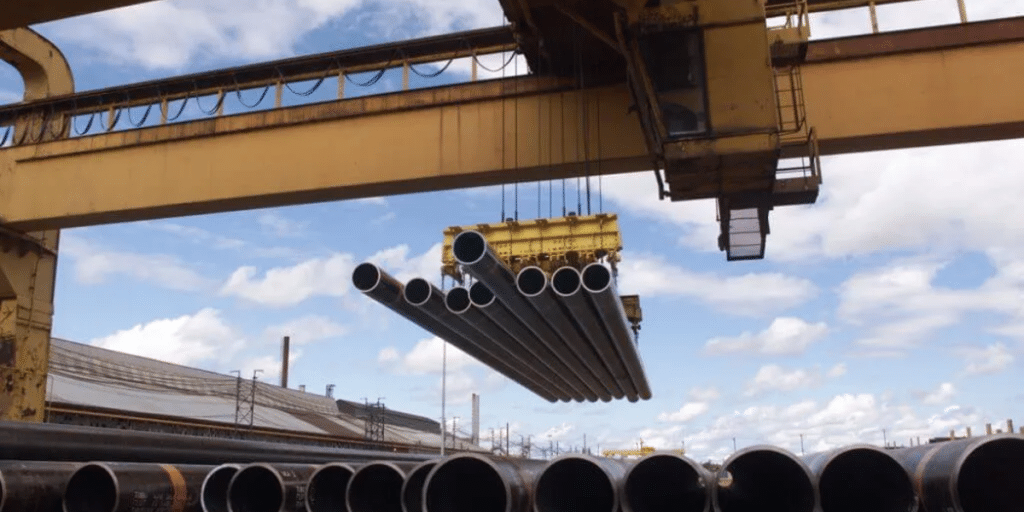- 1. Overview of ASTM A671 and ASTM A672 Steel Pipes
- 2. Comparison of Materials and Manufacturing Processes of ASTM A671 and ASTM A672 Steel Pipes
- 3. Performance Comparison of ASTM A671 and ASTM A672 Steel Pipes
- 4. Application Scenarios and Case Analysis of ASTM A671 and ASTM A672 Steel Pipes
- 5. Cost and Maintainability Comparison Between ASTM A671 and ASTM A672 Steel Pipes
In the steel pipe industry, ASTM A671 and ASTM A672 are two widely used standards, commonly applied in oil and gas transmission, chemical pipelines, water supply systems, and other industrial applications. While these two types of steel pipes share many similarities, they also have significant differences in performance requirements, manufacturing processes, and areas of application. Understanding the characteristics of both and their respective usage scenarios is crucial for engineers and procurement professionals when selecting the appropriate materials.
This article will provide a detailed comparison and analysis of ASTM A671 steel pipes and ASTM A672 steel pipes, highlighting the differences in quality control, material specifications, and applications, offering valuable insights to guide decision-making in practical use cases.
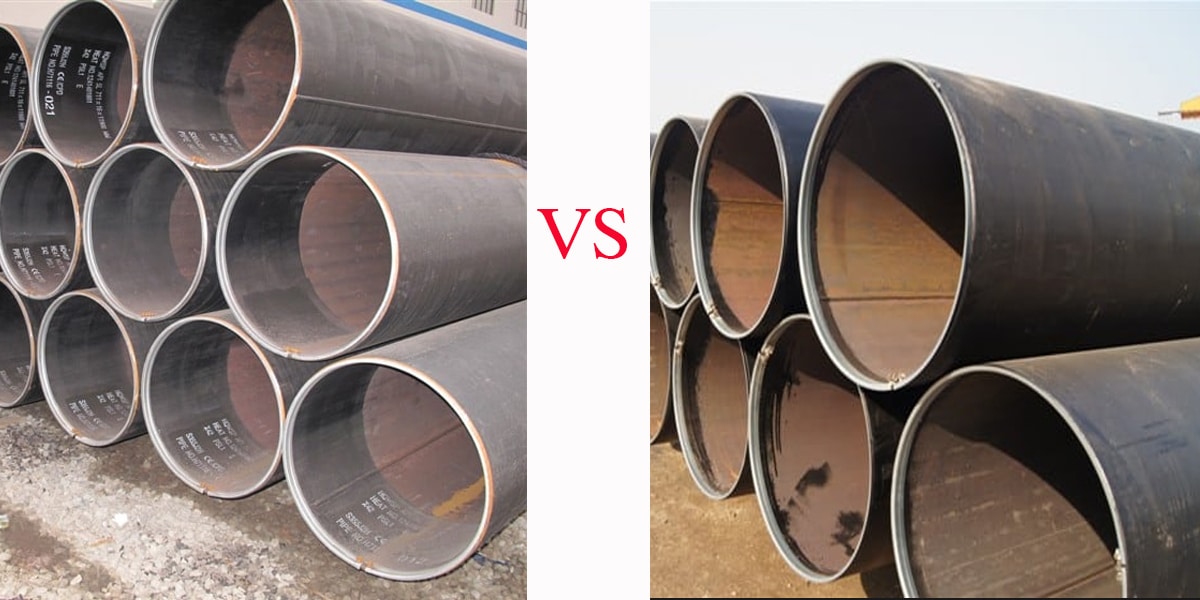
Overview of ASTM A671 and ASTM A672 Steel Pipes
ASTM A671 Steel Pipes
ASTM A671 is a standard specification for electric-resistance-welded (ERW) steel pipes used primarily in the fabrication of welded carbon steel pipes intended for use in low-temperature and moderate-pressure environments. These pipes are commonly used in the oil and gas, chemical, and water treatment industries, where the pipes are subjected to moderate pressure levels and need to withstand exposure to both low temperatures and corrosive environments.
Key features of ASTM A671 steel pipes include:
Material: Primarily made from carbon steel.
Welding Process: Uses submerged arc welding (SAW), providing high-quality, strong welds.
Applications: Commonly used for pipeline systems carrying oil, gas, water, and chemical substances under moderate pressure.
Quality Control: Subject to stringent testing such as hydrostatic testing, impact testing, and non-destructive testing to ensure the pipe meets mechanical and dimensional standards.
ASTM A672 Steel Pipes
ASTM A672, on the other hand, is a specification that covers electric-resistance-welded steel pipes made from high-strength low-alloy steel. This standard is primarily intended for high-pressure applications such as steam, gas, and petroleum pipelines that are subjected to higher operational pressures.
Key features of ASTM A672 steel pipes include:
Material: Made from high-strength low-alloy carbon steel that provides enhanced mechanical properties and resistance to cracking.
Welding Process: Like ASTM A671, ASTM A672 pipes also utilize submerged arc welding for superior weld strength.
Applications: Typically used in more demanding conditions, such as pipelines carrying high-pressure steam, gas, and petroleum.
Quality Control: This standard also mandates comprehensive testing, including hydrostatic pressure tests, impact tests, and chemical composition analysis, to ensure the pipes can withstand high-pressure environments.
Key Differences Between ASTM A671 and ASTM A672 Steel Pipes: While both ASTM A671 and ASTM A672 steel pipes share similarities in terms of material and manufacturing processes, they differ primarily in their pressure tolerance, mechanical properties, and intended applications. ASTM A672 is generally preferred for higher pressure and more demanding applications due to its enhanced mechanical properties, while ASTM A671 is more commonly used for moderate-pressure pipelines in less extreme conditions.

Comparison of Materials and Manufacturing Processes of ASTM A671 and ASTM A672 Steel Pipes
1. Material Comparison
ASTM A671 Steel Pipes:
ASTM A671 steel pipes are primarily made from carbon steel (typically low-carbon or medium-carbon steel). The material selection focuses on good weldability and corrosion resistance, making it suitable for applications involving moderate pressure and low temperatures. The chemical composition requirements are relatively lenient, emphasizing weldability and strength.
ASTM A672 Steel Pipes:
ASTM A672 steel pipes, on the other hand, are made from high-strength low-alloy steel (HSLA). This material provides superior tensile strength and crack resistance, making it suitable for high-pressure applications. Compared to ASTM A671, ASTM A672 has stricter material requirements, especially for high strength and resistance to high-pressure conditions, with the use of alloying elements (such as chromium, nickel, and molybdenum) to enhance its mechanical properties and fatigue resistance.
2. Manufacturing Process Comparison
Manufacturing Process of ASTM A671 Steel Pipes:
ASTM A671 steel pipes are manufactured using the electric-resistance welding (ERW) technique. This process involves heating the edges of the steel and applying pressure to fuse them together. It is a commonly used welding method for producing pipes designed to withstand moderate pressures, and after welding, the pipes usually undergo post-weld heat treatment (such as tempering) to improve the properties of the welded joints. ASTM A671 pipes are also subjected to various quality control tests, such as hydrostatic tests, impact tests, and non-destructive testing.
Manufacturing Process of ASTM A672 Steel Pipes:
Similar to ASTM A671, ASTM A672 steel pipes are also produced using the electric-resistance welding (ERW) process. However, the raw material used for ASTM A672 pipes is high-strength low-alloy steel, which requires more precise control over welding temperature and speed to ensure the welds can withstand high-pressure environments. ASTM A672 pipes also undergo post-weld heat treatment. Due to the special material requirements, these pipes undergo stricter performance testing, including chemical composition analysis and high-pressure hydrostatic testing, to ensure the pipes can handle more demanding pressure conditions.
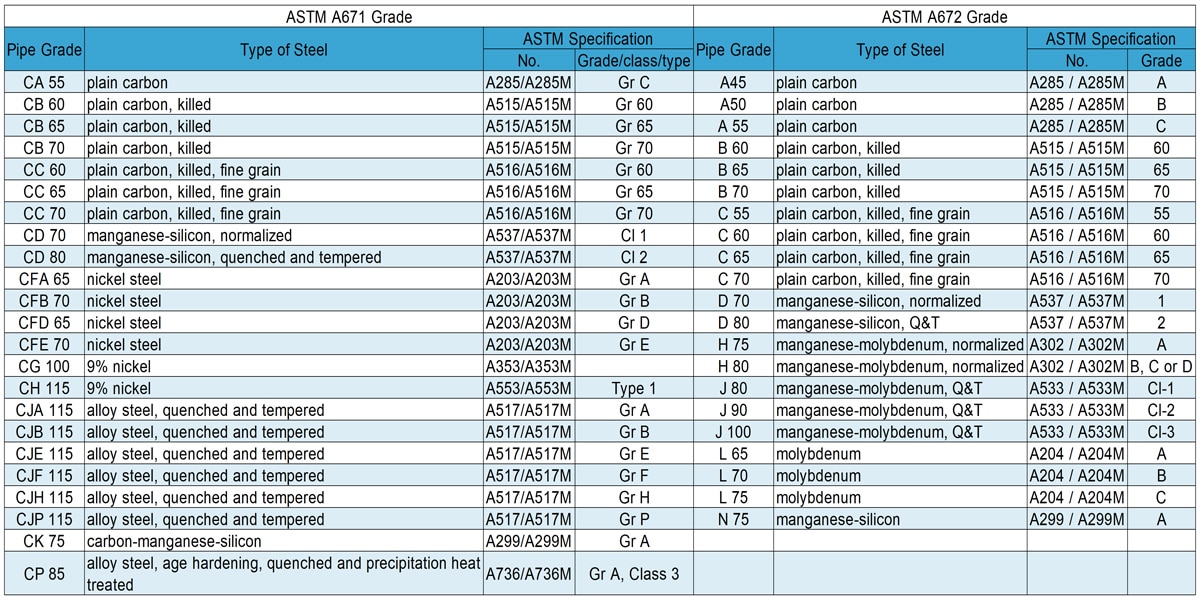
Performance Comparison of ASTM A671 and ASTM A672 Steel Pipes
1. Mechanical Properties
ASTM A671 Steel Pipes: ASTM A671 steel pipes are designed for moderate pressure and low-temperature applications. The mechanical properties of these pipes are suitable for environments where the demand for tensile strength, yield strength, and impact resistance is moderate. The material used in ASTM A671 pipes typically provides sufficient performance in low to moderate stress conditions. However, the mechanical strength is not as high as ASTM A672 due to the lower alloy content in the steel.
Key Mechanical Properties:
Yield Strength: Moderate
Tensile Strength: Moderate
Impact Resistance: Suitable for low to moderate impact conditions
Ductility: Good for moderate pressure environments
ASTM A672 Steel Pipes: ASTM A672 steel pipes, made from high-strength low-alloy steel (HSLA), have superior mechanical properties compared to ASTM A671 pipes. These pipes are specifically designed to withstand higher pressures and more demanding conditions. The higher tensile strength, yield strength, and better resistance to cracking make them suitable for applications under high-pressure environments. The increased alloy content provides enhanced performance in harsh operating conditions, including high pressure, temperature extremes, and potentially corrosive environments.
Key Mechanical Properties:
Yield Strength: Higher compared to ASTM A671
Tensile Strength: Higher, capable of withstanding higher pressure
Impact Resistance: Enhanced, suitable for high-impact applications
Ductility: Suitable for high-pressure environments, with better fatigue resistance
2. Pressure Tolerance
ASTM A671 Steel Pipes: These pipes are designed for moderate-pressure applications. While they can handle some pressure, their structural integrity is best maintained when used in environments that do not exceed certain pressure thresholds. They are typically used in oil and gas, water treatment, and chemical pipelines where pressures are moderate and the conditions are not extreme.
ASTM A672 Steel Pipes: ASTM A672 pipes are intended for high-pressure applications, making them more suitable for steam, gas, and petroleum pipelines that operate under significantly higher pressure levels. The increased alloy content and superior mechanical properties enable ASTM A672 pipes to maintain structural integrity even under high-stress, high-pressure conditions.
3. Durability and Resistance to Cracking
ASTM A671 Steel Pipes: Due to the lower alloy content, ASTM A671 steel pipes have a moderate level of resistance to cracking and fatigue. While they perform well in environments with lower demands, they may not be as resilient under extreme conditions or fluctuating pressures. They are still capable of withstanding regular operational stress, but they are not the ideal choice for environments with significant thermal or pressure cycling.
ASTM A672 Steel Pipes: ASTM A672 pipes, made from high-strength low-alloy steel, exhibit superior resistance to cracking, especially in high-pressure and high-temperature conditions. The material’s improved toughness and fatigue resistance make these pipes suitable for demanding environments, such as in oil and gas pipelines or high-pressure steam systems. Their ability to withstand thermal and pressure cycles without cracking makes them ideal for high-stress applications.
4. Corrosion Resistance
ASTM A671 Steel Pipes: ASTM A671 steel pipes offer moderate corrosion resistance, making them suitable for most industrial applications involving low-pressure systems. However, they may require additional coatings or treatments if exposed to highly corrosive substances or environments.
ASTM A672 Steel Pipes: ASTM A672 pipes, with their higher alloy content, provide better corrosion resistance compared to ASTM A671 pipes. They are more suitable for corrosive environments, including those found in high-pressure and high-temperature applications, such as chemical and petroleum pipelines.
Application Scenarios and Case Analysis of ASTM A671 and ASTM A672 Steel Pipes
1. Application Scenarios of ASTM A671 Steel Pipes
ASTM A671 steel pipes are primarily used in medium-pressure, low to medium-temperature pipeline systems and excel in the following scenarios:
Oil and Gas Transportation: Used in medium-pressure oil and gas transportation pipelines, particularly in areas where pressure requirements are not very high.
Water Treatment Pipelines: Commonly used in water treatment plants to transport potable and wastewater, especially in medium-pressure systems.
Chemical Pipelines: Suitable for chemical pipelines that experience moderate corrosion and low to medium pressure.
Heat Exchange Systems: Used in heat exchange systems with lower temperature and pressure requirements, particularly in energy and HVAC applications.
Case Analysis:
Oilfield Gathering Pipelines: In some non-extreme environments, ASTM A671 steel pipes are used for oilfield gathering pipelines. Due to their suitability for medium-pressure and relatively low corrosion environments, ASTM A671 pipes effectively handle the transportation of natural gas and crude oil.
Municipal Water Supply Systems: ASTM A671 steel pipes are widely used in municipal water supply systems. Their corrosion resistance and good mechanical properties make them an ideal choice for water supply pipelines.
2. Application Scenarios of ASTM A672 Steel Pipes
ASTM A672 steel pipes are more suited for high-pressure, high-temperature, and extreme environments. They are commonly applied in the following scenarios:
High-Pressure Oil and Gas Pipelines: Used in the oil and gas industry for high-pressure transportation pipelines, especially in extreme geographical conditions.
Steam Pipelines: Commonly used in high-temperature steam pipelines in power generation and chemical industries.
Chemical Plants and Refineries: Used in pipelines subjected to high temperature, pressure, and corrosive environments in petrochemical and refining processes.
Offshore Platforms and Subsea Pipelines: Due to their excellent corrosion resistance and high-pressure capabilities, ASTM A672 pipes are widely used in offshore platforms and subsea pipelines.
Case Analysis:
Subsea Oil and Gas Transport: In deepwater oil and gas field development, ASTM A672 steel pipes are used for high-pressure subsea oil and gas transportation pipelines. Their high strength and corrosion resistance make them ideal for deep-sea environments, ensuring the safe transport of oil and gas.
Power Plant Steam Pipelines: In certain power plants, ASTM A672 steel pipes are used for high-temperature steam pipelines. Their superior performance under high-pressure and high-temperature conditions ensures long-term reliability in such extreme environments.
Cost and Maintainability Comparison Between ASTM A671 and ASTM A672 Steel Pipes
When selecting steel pipes for different applications, cost and maintainability are two critical factors that must be carefully evaluated. Both ASTM A671 and ASTM A672 steel pipes have unique features that affect their overall cost and long-term maintenance requirements. Here’s a comparison of the two based on these aspects:
1. Cost Comparison
ASTM A671 Steel Pipes: ASTM A671 pipes are typically lower in cost compared to ASTM A672 due to their composition and manufacturing process. These pipes are suitable for medium to low-pressure applications and are often used in industries where the environmental conditions are not extreme. The material and design requirements for ASTM A671 steel pipes are less demanding, which leads to a more affordable price point. For projects where cost is a key consideration and performance requirements are moderate, ASTM A671 is an ideal choice.
ASTM A672 Steel Pipes: ASTM A672 pipes, on the other hand, are generally more expensive. They are designed for high-pressure, high-temperature, and corrosive environments. The manufacturing process is more complex, and the material composition includes higher alloy content, which contributes to the higher cost. ASTM A672 pipes are often selected for more demanding applications, such as those in the oil and gas industry, where reliability and performance under extreme conditions are critical. While more expensive, these pipes offer better durability and performance, making them a long-term investment in challenging environments.
2. Maintainability Comparison
ASTM A671 Steel Pipes: Since ASTM A671 pipes are used in less demanding environments, their maintainability is generally lower. They are suitable for systems with moderate pressure and temperature conditions, which do not put as much stress on the material. Consequently, they are less prone to wear and tear and corrosion compared to ASTM A672 pipes, making maintenance requirements relatively infrequent and cost-effective. However, regular inspections are still necessary to ensure the pipes are performing optimally, especially in environments with moderate exposure to corrosive elements.
ASTM A672 Steel Pipes: ASTM A672 pipes are designed to handle more extreme environments, such as high-pressure, high-temperature, and corrosive conditions. As a result, they require more stringent maintenance protocols to ensure their longevity. These pipes are built to resist damage in tough conditions, but they may still require periodic maintenance, particularly when subjected to extreme stress or environmental factors such as high humidity or exposure to harsh chemicals. Though their durability is superior, regular inspections and maintenance are essential to ensure they continue to perform at their best and to prevent costly failures. However, their ability to withstand extreme conditions means that, over time, they generally require fewer repairs compared to pipes that are less suited to such environments.
3. Long-Term Cost Efficiency
ASTM A671 Steel Pipes: While the upfront cost of ASTM A671 pipes is lower, they may incur higher maintenance costs over time in certain applications, especially in more challenging environments. If these pipes are used in applications that eventually face corrosion or wear from extreme conditions, replacement or repair costs could increase. The overall long-term cost may be higher than initially expected in these cases.
ASTM A672 Steel Pipes: Although ASTM A672 pipes have a higher initial cost, they offer better long-term cost efficiency in demanding applications. Their higher strength, resistance to corrosion, and ability to withstand extreme conditions reduce the frequency of repairs and replacements. Over time, this can result in significant cost savings in terms of maintenance and pipe replacements, especially in industries where downtime or failure would lead to substantial operational losses.
Case Analysis: Cost and Maintenance Strategies in Real Projects
Case 1: Water Treatment Plant – ASTM A671: In a water treatment plant, ASTM A671 steel pipes were selected for the transport of treated water under moderate pressure. The plant operates in a relatively stable environment with mild temperature and low corrosion exposure.
Case 2: Offshore Oil Rig – ASTM A672: In an offshore oil rig, where high-pressure oil transportation and exposure to harsh sea conditions were critical factors, ASTM A672 steel pipes were chosen for the pipeline system. The environment involved high temperatures, pressure, and severe corrosion risks from saltwater exposure.
Cost and Maintenance Comparison
ASTM A671: Ideal for applications with lower pressure and mild environmental conditions, ASTM A671 offers a cost-effective solution, with maintenance primarily focused on inspections and routine checks. It is suitable for applications where pipe integrity is less likely to be compromised.
ASTM A672: Suitable for high-pressure, high-temperature, and corrosive environments, ASTM A672 offers superior durability but comes with higher initial costs and more complex maintenance strategies. However, its long-term reliability and reduced failure rates in harsh environments lead to lower overall costs in demanding projects.

